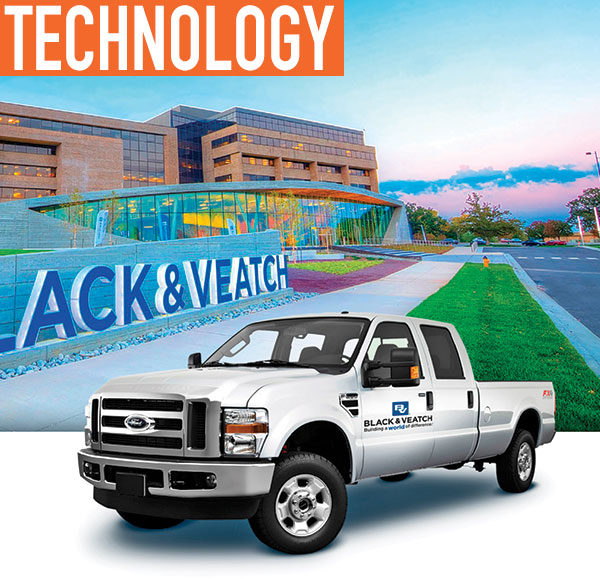Black & Veatch is a global engineering and construction company, specializing in critical utilities, including energy, water, and telecommunications, with more than 11,000 employees in more than 100 countries. Many people rely on the company’s services to keep their everyday lives and businesses going. It’s essential that Black & Veatch’s mobile workers arrive on time and safely, so they can get the job done. Jeff Hill, fleet manager for Black & Veatch (Construction Equipment and Fleet Services) in the US, needed a way to help minimize the risk of accidents and promote better driving.
Based out of Overland Park, Kansas, the Black & Veatch fleet consists of 450 vehicles, including a mix of cars, service trucks (light-duty to heavy-duty), and even a few Class 8 trucks. Many fleet drivers are lone workers, responding to calls in the field. Telecom workers in particular put in many miles on the road, driving from cell tower to cell tower performing upgrades or maintenance. Some workers can drive up to 7,000 miles per month.
The goal was to increase driver safety and decrease accidents and liability. Safety is priority number one at Black & Veatch, not only for its professionals, but for its clients, contractors, vendors, and partners. As noted by Hill, “Through strong leadership and empowered professionals, we collaboratively minimize risk to achieve ‘Zero Injuries Today.’” The challenge was to find a solution that could accurately measure performance and also motivate the diverse group of drivers.
THE SOLUTION
The solution was to increase transparency and accountability via a driver safety scorecard, which was implemented to better identify at-risk drivers. With Geotab’s support, Black & Veatch developed the rules and fine-tuned the parameters. The driver scorecard allowed Black & Veatch to clearly pinpoint issues and see which drivers needed additional training.Previously, Black & Veatch was using different providers and two different telematics systems. Once the Geotab fleet management solution was installed and running, the process was streamlined. With all the data together in one system, it was possible to see driving trends and ways to enhance performance.
A policy was developed to help ensure all drivers followed specific safety guidelines, with driver safety scores reported each month to supervisors, the management team, and communicated to employees.
FEWER ACCIDENTS
Within the first year of the program, Hill started seeing positive results.
Black & Veatch started the driver’s scorecard in 2015. The company’s current goal is to get below five accidents per million mile (PMM), down from nine accidents PMM. To date, Black & Veatch has reduced driver accidents by 46 percent since 2014. Hill says, “Our total miles have dropped off over the last couple of years, but our accident rate continues to decrease.” The data shows that Black & Veatch could reduce close to 30 accidents in a 12-month period.
SCORECARD DETAILS
In its driver safety scorecard, Black & Veatch focused on speeding and seat belt use. The top weighted rule was speeding 15 mph over the posted speed limit. If a driver broke that rule, it would affect his/her score the most. The second most important rule was the company speeding guideline. Seat belt use rounded out the top three. Excessive acceleration, harsh braking, and harsh cornering were also incorporated in the score.
The flexibility of the scorecard allowed Black & Veatch to set their rules by specific speed and time parameters. Rules were designed to enforce policy, while accommodating specific situations that drivers might encounter on the jobsite.
ABOUT DRIVER SCORECARDS
Geotab’s (MyGeotab) driver scorecards provide advanced insight into the on-road activities of drivers, including evaluation of driving behavior, productivity, or check engine health risks and compliance violations. The driver safety scorecard shows which drivers or vehicles need training with certain behaviors. Managers can review daily, weekly, or monthly driving trends and develop performance benchmarks. The report can be customized to a fleet’s specific needs.
HOW IT WORKS
Risk and safety scores are assigned to individual drivers based on such factors as speeding, seat belt use, braking habits, degree of corner turn, acceleration, and after-hours vehicle usage.
The basic scorecard includes standard speed bands and idling greater than five minutes. Review incident count and events per 100 miles to create scoring criteria. The overall score for each driver is rated out of 5 (0-1 = poor and 5 = excellent). Up to six rules can be added, including harsh acceleration and cornering. The weight of each rule or the score itself can be adjusted.
Download Geotab’s Safety Driver Scorecard at the www.geotab.com/marketplace.
MOTIVATING DRIVERS
From the beginning, Black & Veatch made an effort to include drivers and help them understand the goals of the program. During the roll-out phase, Black & Veatch held conference calls and enlisted local managers to assist.
A monthly ranking of top 10 and bottom 10 drivers is posted. Scores are also reported monthly to supervisors and the executive team. Positive feedback is provided to employees who improve their driving safety. Special recognition is given in the company’s monthly newsletter to employees who drive over 1,000 miles a month and are in the top 10 of the scorecard. The transparency of the results encourages awareness, not to mention some healthy competition.
Hill worked closely with the drivers, always ready to provide coaching when needed. After the scorecard was implemented, Hill would receive calls from drivers who wanted to improve their score. With the detailed history available in MyGeotab, Hill could run reports showing exactly where and when the infractions occurred.
Individualized feedback helped the drivers understand what was done wrong and how they could improve. Hill saw an immediate improvement in these cases: “They would call back and say, ‘I see it now.’ The drivers would make the changes and I’d see them move right up the scorecard.”
THE RESULTS
Implementing the driver scorecard resulted in fewer accidents and a safer fleet overall. Black & Veatch reduced accidents, lowered the number of high risk drivers, and improved overall driver safety with the driver safety scorecard—a tremendous win for the company and employees. “Reducing speed and focusing on non-aggressive driving has made a huge change for us,” Hill says.
The flexibility of the Geotab solution and simplicity of install were big positives for Black & Veatch, especially since vehicle changes are frequent. At the beginning, Hill was intimidated by the prospect of sorting through all the data, but with Geotab’s help, he learned how to manage the data effectively.
During the implementation, Hill had a weekly call with the Geotab team to learn how to manage the data. Geotab provided suggestions on setting rules and parameters, reporting, and customizing his fleet management dashboard. The monthly call soon became a quarterly one. “That was big for us. Without the support to go through the scenarios, we wouldn’t have moved forward,” Hill says. With Geotab’s help, Black & Veatch was able to turn data into real life results.
UNEXPECTED BENEFITS
In addition to improving driver habits, telematics has helped Black & Veatch increase driver safety in other ways. The Geotab solution provides advance warning of vehicle issues. Hill receives a notification when a vehicle has a dead battery. He is able to reach out to those drivers to check if they need assistance. “I want them to know that I’m not just looking for speeders. I’m watching out for their safety, as well,” he says.
Implementing the Geotab solution has also improved customer service—which was a great side benefit. Black & Veatch assigned a zone to each cell tower. With greater visibility of the fleet it is possible to know when workers are coming and going, and when the work is completed. For example, even though they work on thousands of cell towers, Black & Veatch can tell a client the exact time a specific location was serviced.
PROACTIVE MANAGEMENT
When Black & Veatch started its telematics program, the objective was to track GPS vehicle location. Once the company began reviewing all the data, the goals evolved. Black & Veatch realized telematics was a powerful tool for improving operations and employee safety. Telematics supported the safety goals of the company and helped put it into practice.
Proactive management is important to Hill. Ignoring the issues is not an option. “We can’t put our head in the sand,” he says. “Fleet managers should use their telematics data to better understand and fix the problems in their fleet.”
THE NEXT STEP
Hill plans to continue working with Geotab, to further refine the rules and enhance the program. He wants to keep pushing people to do better and reduce the accident rate to below two accidents per million miles.
Hill says, “I had one of our construction drivers tell us that this is the single greatest safety initiative that Black & Veatch has ever done,” To Hill, that says it all. By monitoring and coaching driving behavior, Black & Veatch is keeping employees safe and protecting other drivers on the road. For Black & Veatch, its employees are its most important asset, and this is one way the company is showing it cares.
FOR MORE INFORMATION
Geotab is a global leader in telematics, providing open platform fleet management solutions to businesses of all sizes. Find out more about Geotab products and services, visit www.geotab.com.
_______________________________________________________________________
MODERN WORKTRUCK SOLUTIONS: MARCH 2017 ISSUE
Did you enjoy this article?
Subscribe to the FREE Digital Edition of Modern WorkTruck Solutions magazine.
![]()




